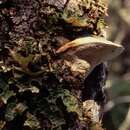en
names in breadcrumbs


Haploporus odorus forms a perennial basidiocarp. You will find it growing almost exclusively on Salix spp. in a sessile or effused-reflexed manner. The pileus is pale buff, darkening with age to a darker dingy brown to black coloration. They can be finely tomentose to almost glabrous and will grow up to 6 × 15 × 8 cm in size. The pore surface is pale buff in color, smooth, corky, faintly zonate, up to 7 cm thick. Pores are 4-5 per mm and circular.
Hyphal system is trimitic; the generative hyphae have clamps, are thin-walled, rarely branched and are 2-3.5 um in diameter; the skeletal hyphae are nonseptate, hyaline, rarely branched and are 3-5 um in diameter; the binding hyphae are thick-walled, 1.5-2.5 um in diameter, nonseptate, hyaline and are very branched.
Haploporus odorus is found north of 52 degrees North latitude in circumglobal Boreal regions. In North America there have been 20 records from British Columbia, with only 4 in the past 20 years. H. odorus a typical taiga species. It grows in swampy coniferous subarctic forest extending south from the tundra. In Europe it is found most commonly in northeastern Sweden, Finland, North Western Russia, a few locations in southeast Norway, Estonia, and Poland.
Haploporus odorus is a perennial hoof-shaped polypore found north of 52 degrees north latitude. There are historical records of its use by the Northern plains native Americans, however observations of this polypore has been limited to British Columbia in North American and northwestern parts of Europe. It grows on Salix sp. (willows) as a high sitting shelf in humid conditions in forest dominated by conifers. This polypore is a white-rot fungus. It has a pale buff to black pileus and a white lower pore layer. The unique features found with H. odorus are the strong smell of aniseed that persists even after drying and dextrinoid spores that are minutely ornamented or echinulated.
Alternate names: Polyporus odorus, Fomitopsis odora, and Trametes odora.

Haploporus odorus is a typical taiga species growing in swampy coniferous subarctic forest extending south from the tundra. It grows almost exclusively on living Salix caprea causing a white-rot decay to occur.
Trametes suaveolens is the only other polypore with a similar macroscopic appearance and odor of anise. However, with T. suaveolens the odor does not remain after drying. _T. suaveolens has an average of 1-3 pores per mm and Haploporus odorus has 4-5 per mm. Microscopically T. suaveolens spores are 7-11 X 3-4 um, while H. odorus has spores measuring 5-6.5 X 3-4.5 um that are distinctly echinulate and slightly dextrinoid. The hyphae of T. suaveolens are thick walled with the absence of cross walls or clamps and are 6-12 um in diameter. H. odorus hyphae will have clamps.
The distribution for T. suaveolens is more southern and includes southern Europe, Ontario and Alberta, Canada and as far south as Iowa and Kansas in the United States. H. odorus is found most commonly in northeastern Sweden, Finland, western Russia, a few locations in southeast Norway, Estonia, and Poland in Europe. In North America H. odorus remains only in a few scattered localities in Canada.
Haploporus odorus has been and still is considered to be a sacred fungus by the northern plains Native American cultures. It is a symbol of spiritual power. The Blackfoot, Blood, Cree are a few of the Indigenous Peoples of the northern American plains that used H. odorus as part of their ornamentation of sacred objects and for medicinal purposes. It was used on sacred robes, necklaces, other cultural properties as well as a component of medicine bundles. The strong anise-like scent produced by H. odorus seems to be the reason for the reverence of this fungus. H. odorus has been found in collections dating back to the 1800s.
The historical information has been sketchy due to incorrect identification, the loss of information passed on by Native American cultures and even an apprehension to discuss fungi for fear of being taboo. Museum articles have been incorrectly labeled as carved cottonwood roots, puffball fungi or the basidiocarp of Fomitopsis officinalis.
The Cree word for H. odorus is “Wikmasigan” according to Creehealer Russedll Willier and is said it “opens the door to the spirit world and allows me to see and hear the spirits.” H. odorus has been used to ward off respiratory diseases and ghosts. It is used in purification rituals as a smudge or an incense.
Blanchette, R. A. 1997. Haploporus odorus: A sacred fungus in traditional Native American culture of the northern plains. Mycologia.89(2): 233-240.